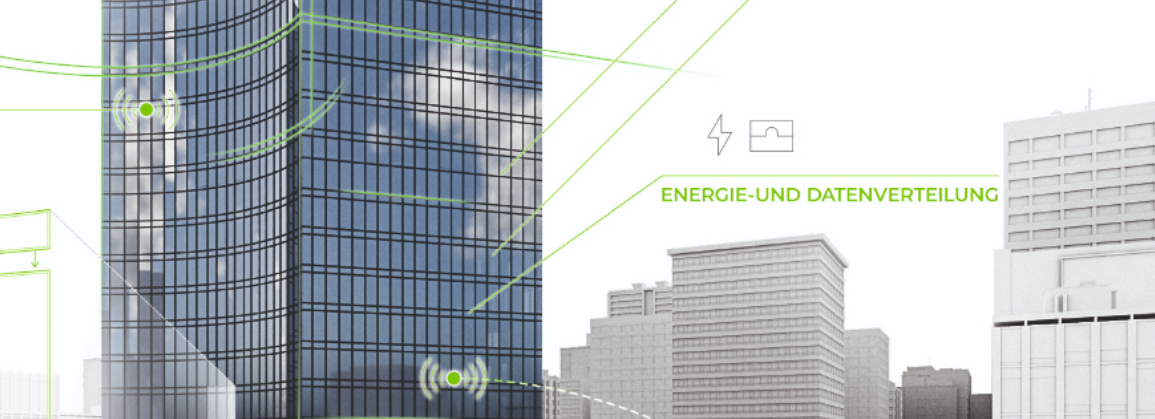News
December 2, 2020
Building the building of the future today
Material innovations, new technologies and digitisation are the answers to new demands in urban building. AluKönigStahl Managing director Ewald Müller sketched out the most important future trends during an interview. Using aluminium and steel systems from the partners Schüco and Jansen, AluKönigStahl provides future-oriented solutions for the buildings of the future.
What does the city of the future look like? How should we imagine a metropolis in the year 2050?
EWALD MÜLLER: The trend in terms of buildings is clearly going in the direction of densification, and particularly verticalisation. As a result of this, the materials and also the technological boundary conditions must already enable these trends. In this way, structures which we are building with our clients today ideally will still be relevant in decades. Here, we are also talking about resource efficiency and conservation as well sustainability – i.e. how and with what am I building at the moment, and how is everything digitised and networked.
Which trends are right at the top of your agenda?
EWALD MÜLLER: In building construction the success factors are freedom to design and planning certainty: Modules which can be combined freely guarantee efficiency and work for multiple different use concepts. Especially in cities, a building is not automatically used in the same way continuously. The challenge is flexibility of use – today and for the next generations. For example, businesses may be located on the ground floor, while in the second and third floor there is a hotel, and right at the top private residents live in a penthouse. With the aluminium and steel systems from AluKönigStahl, we make the design of flexible building concepts possible. Architects retain space for creativity and individuality, while properties can be designed to be resource-conserving, comfortable and sustainable.
Can you give us some specific examples of this?
EWALD MÜLLER: Urbanisation is increasing: More and more people live and work in the cities, space is at a premium. Vertical and “high rise” in many cases is the future of building. In the commercial sector this means: increased use of element facades. Ventilation solutions, sun protection and sound protection can be integrated based on the individual requirements. The visual style of the facade can also be freely chosen based on the cladding. Naturally today the facade offers more than just a visual surface. Mechatronic elements can be linked and controlled via applications – even remotely.
And in the residential segment? What is the emphasis here?
EWALD MÜLLER: Even in the residential sector the customers are asking for maximum design freedom, high strength and sustainability. Energy efficiency is especially important. This means that material and design systems are an incredibly important factor: Here, with BIM (building information modelling) the sector has an extremely efficient collaboration tool. All relevant building data are stored and combined digitally. This allows new and creative solutions to be implemented more cost-efficiently, but also particularly with a lower requirement for resource – naturally also in the commercial sector.
How should we imagine the degree of digitisation?
EWALD MÜLLER: The increasing digitisation also means more energy efficiency. Overarching platforms can control and monitor the mechatronic elements via smartphone. Here open-architecture interfaces allow maximum diversity, since they can be connected into building control systems, just as in Smart Home systems. The users always have an overview thanks to modern technology: Using HD cameras, infrared LEDs and access control systems, the entrance area is always visible and secure. The complete operation and configuration can also be done using an app – even from the sofa on a smartphone.
From the building shell into the interior. What are the innovations here?
EWALD MÜLLER: Naturally the visual appearance alone is not everything. Building vertically also brings major demands in terms of energy efficiency and comfort. Particularly in the major cities for example, it is important that the air is cleaned before it enters the interior. At the same time traffic noise needs to stay outside, for which among other things, special glass and window vents with sound insolation can provide a contribution. In terms of acoustics – if windows are open for example – there is a trend in the direction of active sound insulation i.e. active noise cancellation (ANC). Here there are ANC ventilation modules with integrated loudspeakers, which produce anti-noise, matched to the outside noise. This enables the sound waves which enter to be reduced. In parallel integrated sound-absorbing facade elements contribute to a general reduction in exterior noise. Sun protection with the highest possible wind resistance adds to the highly functional facade.
What distinguishes the building of the future?
EWALD MÜLLER: The sustainable character of the building is made up of the right mix. For sustainable buildings, AluKönigStahl together with its system partners Schüco and Jansen, offers technologies and systems, which work harmoniously with the environmental conditions. Our aluminium and steel systems fulfil all basic principles of sustainable product development. They provide maximum design freedom and a high design affinity, and are also specified for a high degree of usability, user convenience, energy efficiency, resource conservation and climate protection. This means, the systems have a long life and can be recycled. All these technologies enable numerous new approaches and methods, which need to be thought through. This is the quintessence of the approach – and also where the potential for highly efficient building construction lies.
Conclusion: The most important characteristics of the building of the future are therefore:
- Sustainability and sparing use of scarce resources
- Ensuring flexibility of use through modules which can be combined
- Energy efficiency through digitisation (e.g. Smart Home systems)
- Innovative products to adapt to the environment (e.g. active sound insulation)


